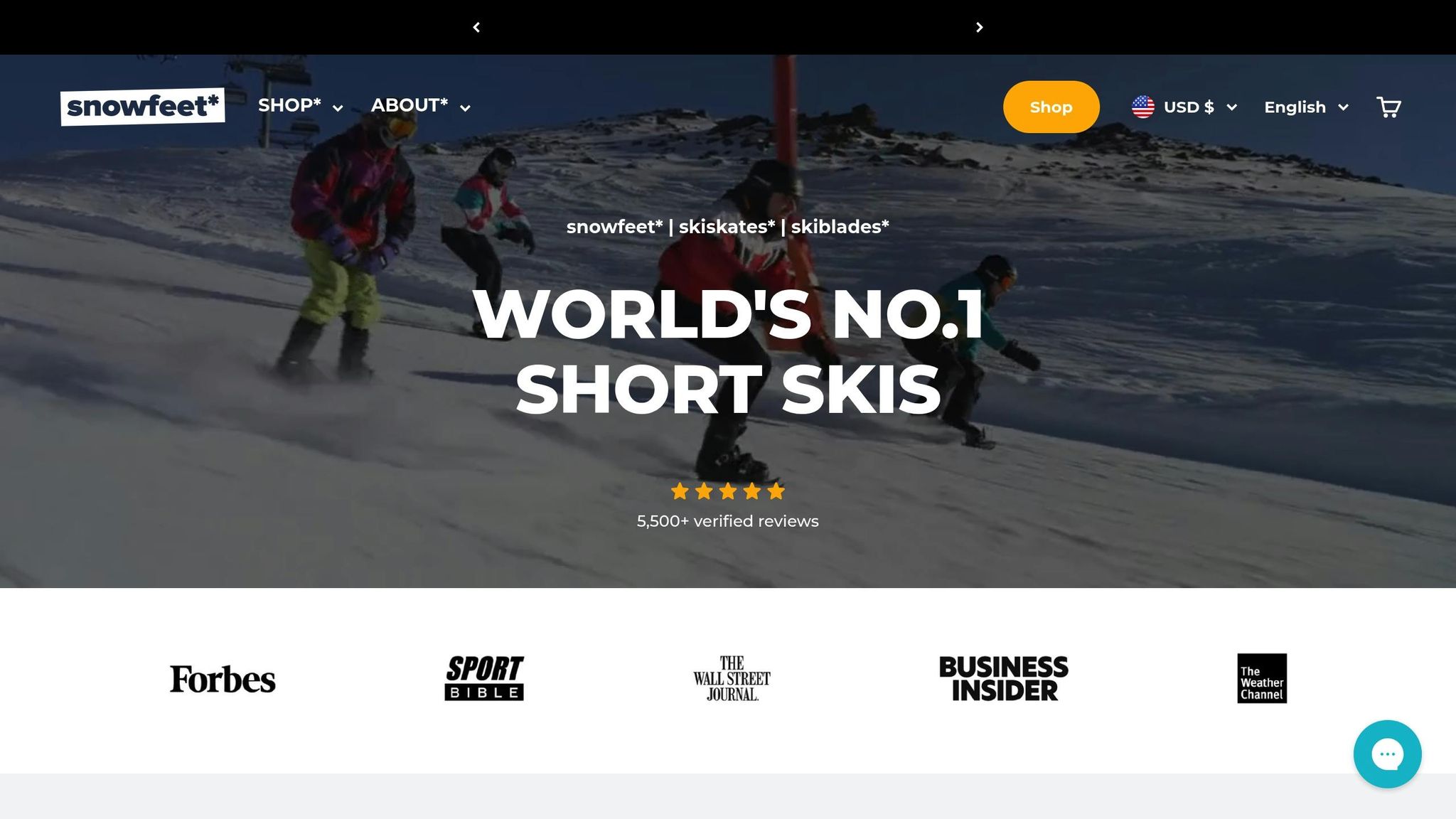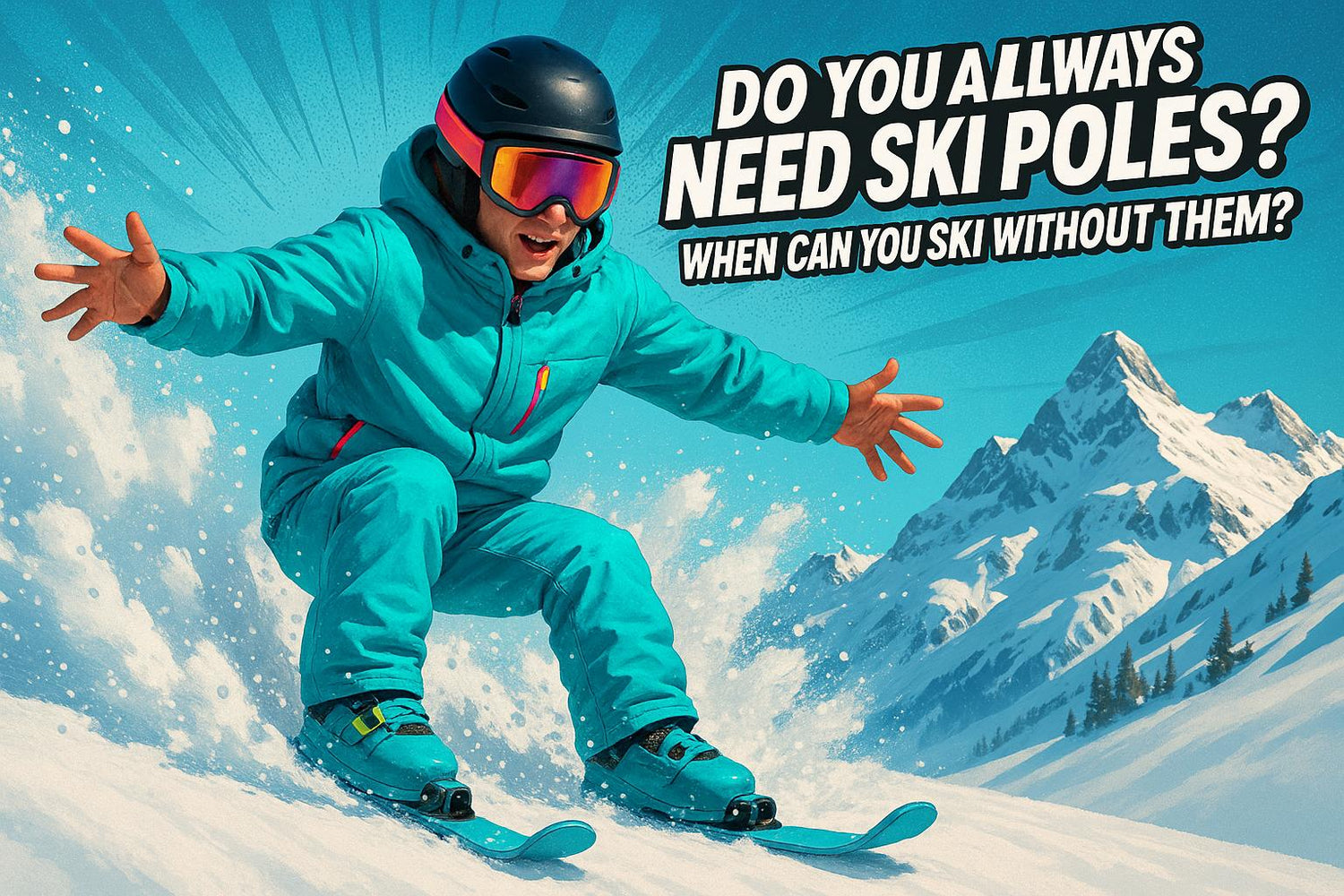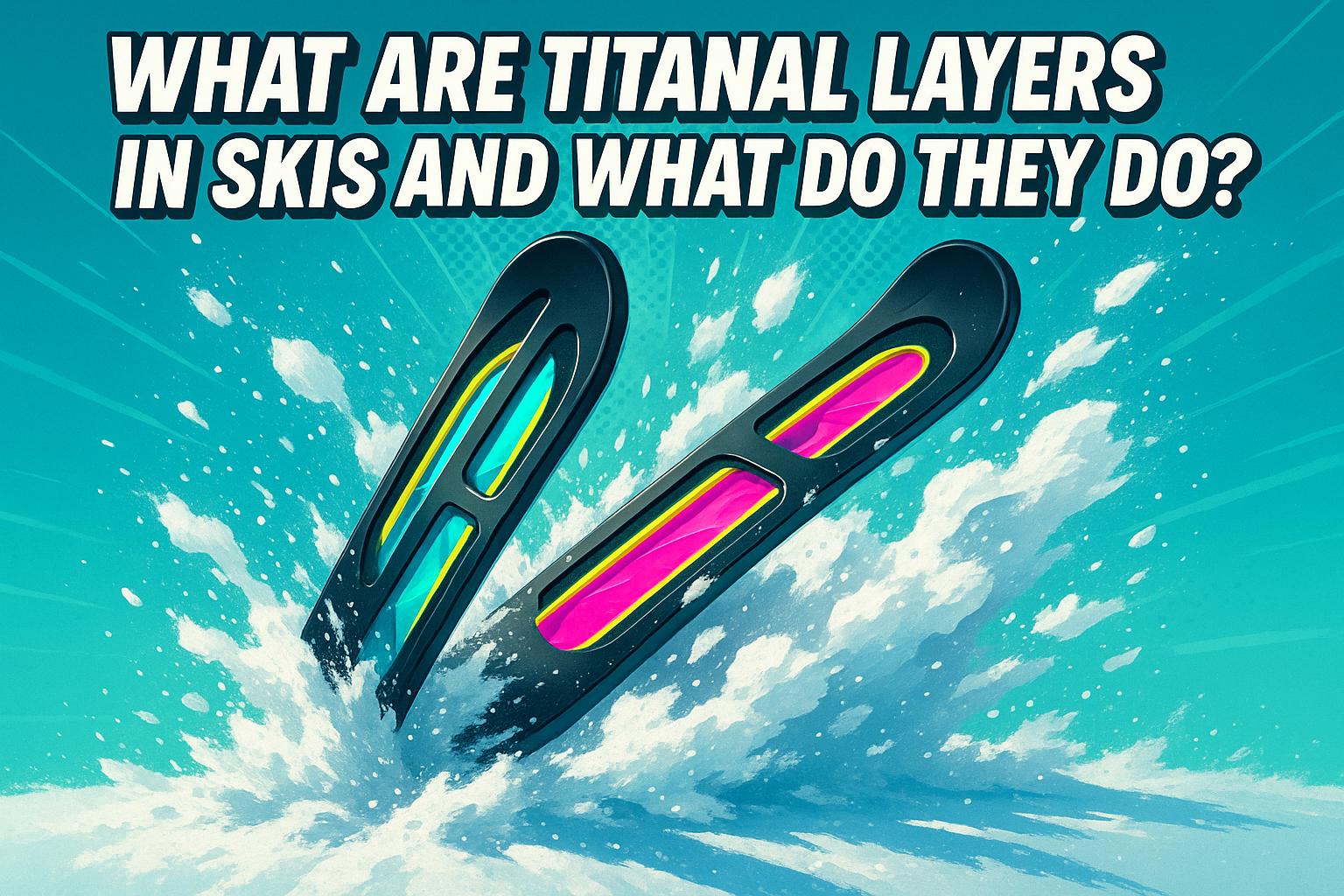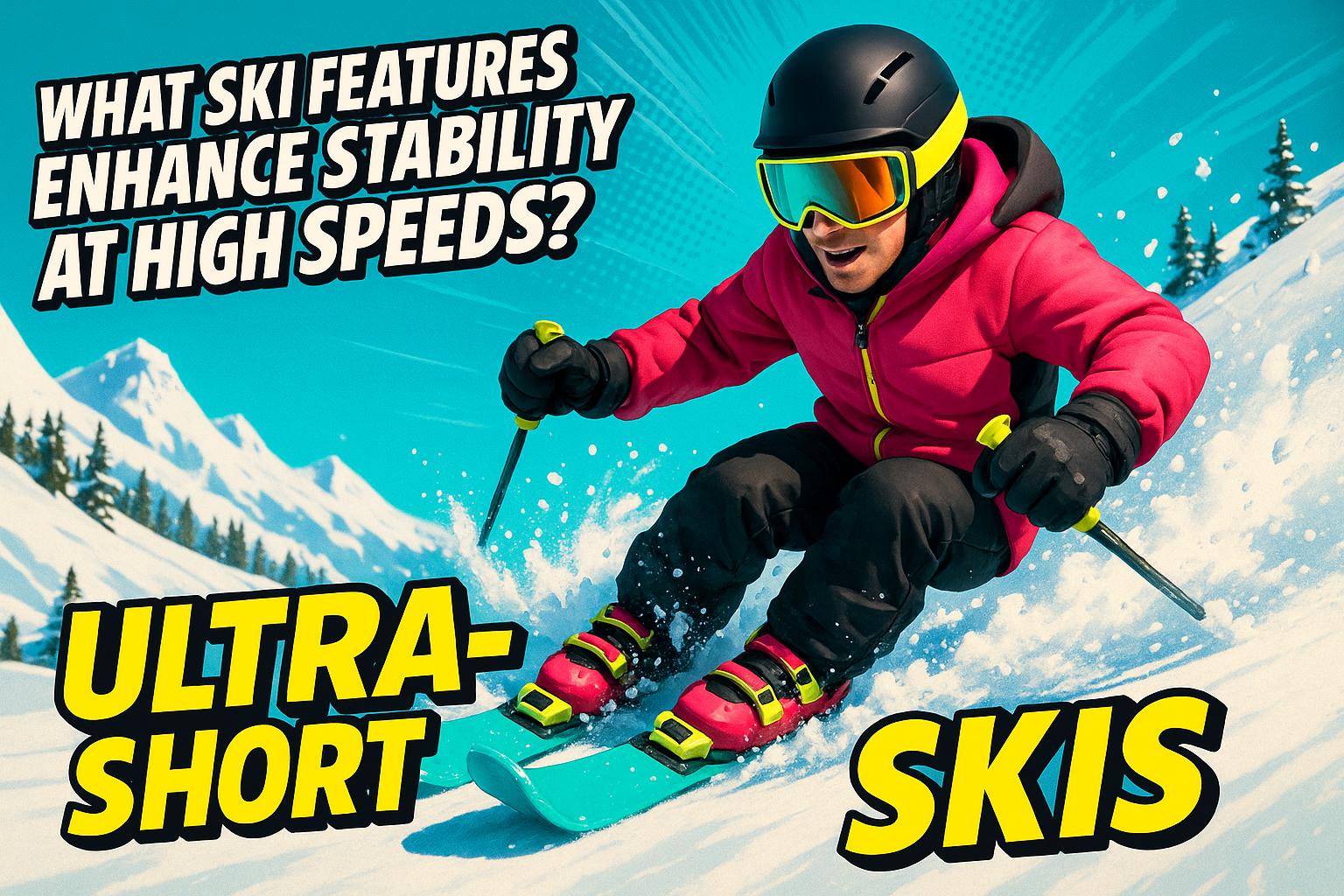Vous n'avez pas toujours besoin de bâtons de ski - cela dépend de votre équipement, de votre niveau et du type de ski que vous pratiquez. Les bâtons aident à l'équilibre, au timing des virages et à la navigation sur un terrain difficile, surtout pour le ski alpin et le ski de fond. Mais avec des skis plus courts comme les Snowfeet Mini Ski Skates ou Skiblades, les bâtons ne sont pas nécessaires. Ces skis compacts sont plus faciles à contrôler, rendant le ski plus simple et plus amusant, surtout pour les débutants ou les skieurs occasionnels.
Voici l'essentiel :
- Les bâtons sont utiles pour les pentes raides, les parcours techniques et le carving rapide.
- Les bâtons ne sont pas nécessaires pour les skis plus courts, les pentes modérées ou les descentes ludiques.
- Les produits Snowfeet (38–120 cm) sont conçus pour le ski sans bâtons, offrant des options légères et portables qui fonctionnent avec vos chaussures habituelles.
Vous voulez skier sans bâtons ? Concentrez-vous sur l'équilibre, la bonne position du corps et la maîtrise des virages. Commencez sur des pentes douces et pratiquez les transferts de poids pour gagner en confiance. Que vous soyez débutant ou simplement à la recherche d'une nouvelle façon de profiter de la neige, abandonner les bâtons peut rendre le ski plus détendu et accessible.
Carving sans bâtons avec Nicola Rota et Luca Siro 🇮🇹⛷👍
Quand vous avez vraiment besoin de bâtons de ski
Snowfeet* peut être un vrai plaisir sur des pentes modérées, offrant une façon unique et amusante de glisser. Mais quand il s'agit de ski alpin expert, les bâtons ne sont pas seulement utiles - ils sont essentiels pour garder le contrôle et gérer un terrain difficile. Décomposons pourquoi les bâtons sont indispensables dans certaines situations.
Ski alpin de niveau expert et pentes raides
Sur les pentes raides où les virages rapides et serrés sont essentiels, les bâtons de ski jouent un rôle crucial. Ils vous aident à maintenir une position corporelle correcte en gardant votre haut du corps orienté vers la descente tout en contrebalançant les forces qui tentent de vous déséquilibrer lors des changements de carre. Tout est question de précision et de contrôle.
PSIA Moniteur de ski certifié Sean Thomas l'explique le mieux :
"Pour le ski alpin, le principal avantage est d'aider à garder votre haut du corps en mouvement vers la pente et orienté vers la descente. Si vous faites tourner vos jambes sous vous, la neige résistera. Utiliser vos bâtons aide votre corps à résister à cette force."
Cathy Harvey, ancienne monitrice de ski PSIA Niveau 1, ajoute :
"À mon apogée dans ce sport, je n'aurais jamais envisagé d'affronter un terrain extrême sans bâtons."
Alors que Snowfeet* est parfait pour cruiser sur des pentes plus douces, les skis traditionnels et les bâtons restent indispensables pour les terrains raides et techniques. Les bâtons ne sont pas que des accessoires - ce sont des outils qui aident au timing, à la coordination et à naviguer avec précision sur des pistes difficiles.
Avantages de skier sans bâtons
Skier sans bâtons peut complètement changer votre façon de bouger sur la neige et faciliter l'apprentissage en réduisant le matériel. Décomposons les principales façons dont abandonner les bâtons peut améliorer votre expérience de ski.
Équilibre amélioré et apprentissage plus rapide
Quand vous skiez sans bâtons, votre corps apprend naturellement à s'équilibrer seul. Sans dépendre des bâtons pour la stabilité, vous activez vos muscles centraux et affinez votre posture pour trouver ce point idéal - votre centre de gravité. Cela vous aide à construire une base solide pour une meilleure technique de ski, permettant à vos bras de bouger librement pour l'équilibre.
Prenez par exemple les Mini Ski Skates (38 cm) de Snowfeet ou leurs modèles PRO (50 cm). Leur design compact les rend plus faciles à contrôler, ce qui vous aide à rester équilibré. Avec moins de longueur de ski à gérer, vous pouvez vous concentrer sur le développement de vos compétences sans vous sentir dépassé.
Liberté pour votre haut du corps
Un autre grand avantage ? Votre haut du corps peut bouger librement. Sans bâtons, vous n'êtes pas lié à des mouvements précis comme planter les bâtons. Au lieu de cela, vos bras aident naturellement à l'équilibre, vous offrant plus de flexibilité. C'est un changement radical quand vous essayez des figures, slalomez entre des passages étroits ou profitez simplement d'une descente détendue.
La différence est particulièrement visible lorsque vous comparez les produits Snowfeet aux skis traditionnels. Par exemple, un ski typique de 170 cm de marques comme Rossignol ou Salomon nécessite un travail minutieux avec les bâtons pour garder le contrôle. En revanche, les Skiskates compacts de 44 cm de Snowfeet vous permettent de vous concentrer entièrement sur les virages carving et le plaisir - sans bâtons. De plus, vos bras sont libres pour faire des high-fives avec vos amis, ajuster votre équipement ou simplement profiter de la glisse.
Plus simple, moins intimidant, et plus amusant
Se passer des bâtons rend aussi le ski plus accessible. Sans l'équipement supplémentaire et la technique, le ski devient moins intimidant pour les débutants et plus agréable pour les skieurs expérimentés. Parfois, c'est agréable de laisser de côté les aspects techniques et de simplement glisser.
Snowfeet mise sur cette idée de simplicité. Leurs produits sont conçus pour rendre le ski facile et amusant, sans équipement inutile qui vous alourdit. Et voici un bonus : la portabilité. Oubliez de transporter de longs skis et des bâtons qui nécessitent des barres de toit ou un emballage soigneux. Le matériel compact de Snowfeet se glisse directement dans un sac à dos, parfait pour les citadins ou quiconque veut une façon sans tracas de dévaler les pistes.
sbb-itb-17ade95
Comment les produits Snowfeet* éliminent le besoin de bâtons

Snowfeet* a réinventé le ski avec un objectif simple : le rendre amusant et facile pour tous. En abandonnant le besoin traditionnel de bâtons, leurs designs élégants et compacts offrent une toute nouvelle façon de profiter des pistes.
Court et léger pour un équilibre naturel
Les skis traditionnels sont longs, lourds, et nécessitent souvent des bâtons pour l'équilibre. Snowfeet* renverse la donne avec des produits allant de 38 à 120 cm de longueur, conçus pour être courts et légers. Prenez par exemple le Mini Ski Skate de 38 cm - il permet à vos pieds de s'équilibrer naturellement, réduisant le besoin de bâtons. De plus, avec moins d'encombrement et de poids, vous économiserez votre énergie pour perfectionner vos mouvements au lieu de traîner du matériel supplémentaire.
Facile à utiliser, installation sans tracas
L'un des plus grands avantages des produits Snowfeet* est leur simplicité d'utilisation. Oubliez les chaussures spécialisées ou les réglages compliqués des fixations - Snowfeet* fonctionne avec les chaussures de ski ou de snowboard que vous possédez déjà. Et quand il est temps de ranger, leur taille compacte facilite le stockage et le transport. Pas besoin de barres de toit ou de sacs surdimensionnés comme avec les skis traditionnels.
Snowfeet* vs. Skis traditionnels et snowboards
Sur les pistes, la différence est claire comme de l'eau de roche. Les skis longs sont conçus pour la poudreuse profonde et le carving à grande vitesse, ce qui est parfait si vous êtes un pro. Mais pour le ski quotidien, ils peuvent sembler excessifs. Les produits Snowfeet* sont conçus pour la polyvalence, que vous dévaliez des pistes damées, que vous alliez au parc, ou même que vous exploriez des sentiers et des collines dans votre jardin.
| Caractéristique | Skis traditionnels | Produits Snowfeet* |
|---|---|---|
| Courbe d'apprentissage | Nécessite souvent des cours | Facile et intuitif |
| Portabilité | Encombrant et difficile à transporter | Compact, se glisse dans un sac à dos |
| Installation | Réglages chronophages | Rapide et simple |
| Nécessité des bâtons | Les bâtons sont indispensables | Pas besoin de bâtons |
| Flexibilité du terrain | Idéal pour les pistes de ski | Fonctionne sur des terrains variés |
Bien sûr, les snowboards n'ont pas besoin de bâtons non plus, mais ils ont leurs propres limites - comme être liés aux systèmes de stations et aux aventures moins spontanées. Snowfeet* change tout cela. Leur design compact et léger vous permet d'explorer où que la neige vous mène, que ce soit un parc local, une colline de quartier ou même un sentier de randonnée enneigé.
Comment skier sans bâtons : conseils pratiques
Skier sans bâtons peut sembler inhabituel au début, mais avec la bonne technique et un peu de pratique, cela peut devenir complètement naturel. Avec le temps, vous réaliserez que votre corps possède tous les outils nécessaires pour rester équilibré et en contrôle sur les pistes.
Position et équilibre corporels appropriés
Pour skier sans bâtons, concentrez-vous sur le maintien d'une position forte et centrée. Gardez les genoux pliés, le tronc engagé, et laissez vos bras pendre naturellement le long du corps. Cette position athlétique aide à fournir la stabilité à laquelle vous vous fiez normalement avec les bâtons.
L'astuce est de faire confiance à l'équilibre naturel de votre corps. Au lieu de vous appuyer sur des bâtons pour le soutien, gardez le haut de votre corps détendu et stable pendant que vos jambes font le travail lourd. Cela peut demander un peu d'adaptation, mais votre corps est plus que capable de s'ajuster.
Si vous utilisez les produits Snowfeet*, cet équilibre devient encore plus facile à atteindre. Leur design plus court maintient votre centre de gravité plus proche de la neige, vous offrant une sensation stable et confiante que vous utilisiez les Skiskates Mini Ski de 38 cm ou les Skiblades de 99 cm.
Comment tourner sans bâtons
Tourner sans bâtons consiste à maîtriser les transferts de poids et le contrôle des carres. Transférez votre poids sur le ski extérieur tout en fléchissant genoux et chevilles dans le virage. Ce mouvement guide naturellement vos skis dans des arcs lisses et contrôlés.
Les skis courts, comme ceux de Snowfeet*, rendent ce processus encore plus intuitif. Leur taille compacte améliore le contrôle et l'agilité, permettant des pivots rapides, des virages serrés et des ajustements faciles comparés aux skis longs traditionnels.
À mesure que vous vous sentez à l'aise avec les virages, le contrôle de la vitesse viendra naturellement. Utilisez des virages plus longs et plus larges pour maintenir votre vitesse ou optez pour des virages plus courts et plus serrés pour ralentir. En changeant fréquemment de direction, vous luttez contre la gravité et gérez votre rythme.
Une fois que vous êtes confiant dans ces techniques, restez sur des pistes adaptées à votre niveau pour continuer à renforcer votre confiance.
Choisir les bonnes pistes
Commencez sur des pistes bleues douces pour pratiquer vos transferts de poids et vos virages dans un environnement contrôlé. Ces pistes ont généralement des conditions de neige constantes, ce qui les rend idéales pour affiner vos compétences sans défis inattendus.
Au fur et à mesure de votre progression, vous pouvez progressivement aborder des terrains plus exigeants. Cependant, évitez les pentes glacées ou raides au début - elles nécessitent un contrôle de carre plus précis, qui devient plus facile à mesure que votre technique se développe.
Les produits Snowfeet* ajoutent une couche supplémentaire de polyvalence à votre expérience de ski. Que vous exploriez des snowparks, des collines locales ou même que vous fassiez de la randonnée vers des zones vierges de la montagne, leur taille compacte rend tout cela possible. Contrairement aux skis et bâtons traditionnels de longueur complète, ils ouvrent un monde de possibilités pour l'aventure et le plaisir.
Conclusion : La liberté de skier sans bâtons
Skier sans bâtons n'est pas juste un ajustement à la tradition - c'est une toute nouvelle façon de vivre les pistes. Il s'agit de simplifier votre équipement, de libérer vos mouvements et de découvrir une connexion plus naturelle avec la neige.
Les produits Snowfeet*, comme leurs Mini Ski Skates (38 cm), Skiskates (44 cm) et Skiblades (65-120 cm), sont conçus pour rendre les bâtons inutiles. Ces designs compacts et équilibrés offrent une stabilité qui vous permet de vous concentrer sur le plaisir, pas sur le matériel.
Sans bâtons, le haut de votre corps est libre de bouger, et votre tronc joue le rôle de vous maintenir en équilibre. Cela accélère non seulement l'apprentissage des compétences, mais renforce aussi votre confiance sur les pistes. De plus, la légèreté et la portabilité du matériel Snowfeet* signifient que vous pouvez le glisser dans un sac à dos et partir à l'aventure - que ce soit dans de la poudreuse vierge, des snowparks ou votre colline locale préférée.
Pour les débutants, cette approche élimine le facteur d'intimidation des équipements traditionnels. Pour les skieurs expérimentés, elle libère un style ludique et dynamique que les longues skis ou snowboards ne peuvent tout simplement pas offrir. Skier sans bâtons semble intuitif, presque comme redécouvrir le sport dans sa forme la plus pure.
Snowfeet* révolutionne le ski conventionnel, montrant que parfois moins d’équipement signifie plus d’aventure.
FAQ
Qu’est-ce qui rend les produits Snowfeet meilleurs que les skis et snowboards traditionnels ?
Les produits Snowfeet révolutionnent les sports d’hiver. Ils sont plus petits, plus légers et plus faciles à manier comparés aux skis et snowboards traditionnels. Grâce à leur taille compacte, ils sont faciles à transporter, ranger et utiliser - parfait pour tous ceux qui veulent dévaler les pistes sans s’encombrer d’un équipement volumineux. Mieux encore, vous pouvez les fixer sur des chaussures d’hiver classiques ou des boots de snowboard, donc pas besoin d’investir dans du matériel supplémentaire.
Grâce à leur longueur plus courte, Snowfeet offrent une manœuvrabilité superbe, rendant les virages serrés et les mouvements rapides sans effort. Ils sont un excellent choix pour les débutants qui s’initient au sport ou les skieurs expérimentés en quête d’une expérience fraîche et ludique. De plus, ils sont plus abordables que les équipements traditionnels, rendant les sports d’hiver plus accessibles sans sacrifier le plaisir.
En résumé, Snowfeet offre une manière élégante, portable et économique de profiter des pistes - moins de tracas, plus de liberté, et tout le plaisir que vous pouvez souhaiter.
Les débutants peuvent-ils apprendre à skier sans bâtons en utilisant les produits Snowfeet ?
Oui, les débutants peuvent tout à fait apprendre à skier sans bâtons, surtout en utilisant les produits Snowfeet. Des options comme les Snowfeet Skiskates (44 cm) ou les Skiblades (65 cm) sont plus courtes, ce qui facilite grandement l’équilibre et le contrôle - parfait pour les novices. En évitant les bâtons, les débutants peuvent se concentrer entièrement sur l’amélioration de leur technique et gagner en confiance sur les pistes.
Ce qui distingue Snowfeet, c’est leur design léger et compact. Cela donne aux apprenants une sensation stable et sécurisée, facilitant le contrôle pendant la pratique. Ces produits éliminent les complications du matériel de ski traditionnel, offrant une manière simple et amusante de s’initier au ski.
Y a-t-il des situations où skier sans bâtons n’est pas idéal ?
Skier sans bâtons n'est pas toujours la meilleure idée, surtout sur des pentes raides ou glacées où l'équilibre et les ajustements rapides sont cruciaux. Les bâtons sont utiles pour naviguer dans des zones délicates comme les forêts denses ou les terrains accidentés, vous offrant cette stabilité et ce contrôle supplémentaires.
Pour les débutants ou ceux qui affrontent des conditions difficiles, les bâtons peuvent renforcer la confiance et offrir un soutien indispensable. Mais avec le matériel Snowfeet - comme les skiblades, Skiskates ou mini skis - le design compact et la maniabilité facile signifient que vous pouvez souvent vous passer complètement des bâtons. Ces produits sont conçus pour vous donner plus de liberté et rendre le ski récréatif un jeu d'enfant.
Articles de blog connexes
- Skis de neige pliables compacts : avantages et inconvénients
- Comment choisir des skis pour différentes conditions de neige (poudreuse, pistes damées, glace)
- Comment choisir les bons bâtons de ski pour ma taille ? (Ou en ai-je besoin avec des Short Skis ?)
- Les skis de fond sont-ils adaptés aux débutants ? Ce que vous devez savoir avant de commencer


































Laisser un commentaire
Ce site est protégé par hCaptcha, et la Politique de confidentialité et les Conditions de service de hCaptcha s’appliquent.